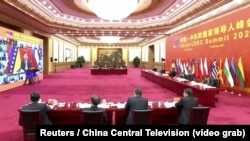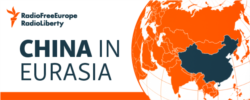Chinese leader Xi Jinping has chaired a long-delayed summit with Central and Eastern European countries amid growing division in the region over how to view Beijing's growing influence.
The February 9 virtual meeting that took place via video link focused on access to COVID-19 vaccines and post-pandemic economic recovery as Beijing convened the 17+1 bloc -- a format launched in 2012 for China to engage with Central and Eastern European nations, of which 12 are European Union members.
The summit took place after more than a year of delays and friction as Beijing looked to capitalize on the momentum of a EU-China investment deal signed in late 2020 and to highlight its growing ties with the continent by having Xi lead the event in place of Chinese Prime Minister Li Keqiang, the usual top official.
But Beijing's preferred optics were overshadowed by the geopolitical backdrop of the summit, in which many Central and Eastern European countries have grown frustrated with China's unkept promises for trade and investment.
Many are also increasingly sensitive to concerns that the 17+1 is being used to divide European Union policy on China.
In a sign of growing skepticism in the region toward China, six countries -- Bulgaria, Estonia, Latvia, Lithuania, Romania, and Slovenia -- elected to send ministers instead of their head of state or government.
The episode highlights a growing split taking place in Central and Eastern Europe in which many countries have a more sober assessment of engagement with China and are carefully positioning themselves between Beijing and Washington amid the deepening rivalry.
"There is a more realistic approach being taken to China and the 17+1 format," Frank Juris, an expert on China's role in the region at the Estonian Foreign Policy Institute under the International Center for Defense and Security in Tallinn, told RFE/RL. "This is not only true for the Baltic states, but the wider region. There has been almost a decade of Chinese promises that we haven't seen develop."
In addition to the countries that sent lower-level representation, the 17+1 group also includes European Union members Croatia, the Czech Republic, Greece, Hungary, Poland, and Slovakia -- and prospective members Albania, Bosnia-Herzegovina, North Macedonia, Montenegro, and Serbia.
With ties between the United States and China frosty and the new U.S. administration of President Joe Biden looking for greater coordination with Europe in helping to counterbalance Beijing, many countries are sensitive to tensions between the two larger powers. This remains especially true for countries in Central and Eastern Europe that see Russia as their main defense issue and are dependent on close security cooperation with both the United States and NATO.
"On the China issue, there is a split in the European Union between old member states and new member states," Ivana Karaskova, the founder of China Observers in Central and Eastern Europe (CHOICE) and a China research fellow at the Association for International Affairs in Prague, told RFE/RL. "In 17+1 you have a number of U.S. allies that are more receptive to American goals."
China Looms Large
Despite the cooling ties between Beijing and some 17+1 members, China’s stature has also grown more prominent in recent years.
The signing of the European Union-China Comprehensive Agreement on Investment (CAI) in late December 2020 marked a geopolitical win for China and sent a message to Washington that Beijing’s connections to Europe would be a more permanent fixture, despite lingering concerns over the deal in the European Parliament.
What role Europe will play in U.S.-China tensions is a focal point of policy discussions in both Beijing and Washington.
While Jake Sullivan, President Biden's national-security adviser, has spoken about the need to work more closely with European countries in the United States’ competition with China, Chinese Foreign Minister Wang Yi encouraged the EU during a video meeting with the bloc's foreign-policy chief, Josep Borrell, on February 8 to act "independently and autonomously" amid the growing rivalry.
In reconvening the 17+1 group again, China is hoping to continue that success and help ensure the format's continued relevance after last year’s in-person summit was canceled due to the coronavirus pandemic. But the informal bloc has so far delivered meager trade and investment results for its members since it was launched in 2012.
According to the Mercator Institute for China Studies, a Berlin-based think tank, nearly 50 percent of EU exports to China are from Germany, followed distantly by France.
Similarly, Chinese trade with the 17 Central and Eastern European countries reached $100 billion for the first time in 2020. Achieving that benchmark, however, was first put forward in 2012 at the first 17+1 summit, with the goal of achieving it by 2015.
Instead, China used the February 9 summit to push for the further use of Chinese-made vaccines in Central and Eastern Europe as the EU faces shortages. Beijing also pledged to import more than $170 billion in farm products from the region over the next five years.
Hungary, which maintains strong ties with Beijing, already became the first European Union country to sign up for distribution of China's Sinopharm vaccine, and Czech Prime Minister Andrej Babis indicated last week that his government could follow.
Serbia, North Macedonia, and Montenegro have also either already purchased Chinese vaccines or expressed a strong interest in doing so. Serbia, which is one of China's closest partners in the region, has relied heavily on the Chinese injections for its rollout campaign.
Entering A New Period
China's efforts to shore up its ties in Central and Eastern Europe come after a largely successful U.S. campaign to persuade European nations to restrict Chinese operators from Chinese 5G networks.
Limiting providers such as Huawei and ZTE from next-generation networks was a priority of the administration of President Donald Trump and a policy that Biden looks to continue due to security concerns that the Chinese equipment could be used to spy.
Both Chinese telecom giants deny those allegations.
Some of the strongest support for the U.S. measures came from Central and Eastern Europe, with a number of countries from the region signing onto the United States’ Clean Network Initiative, committing to use other non-Chinese vendors for their networks.
Central and Eastern European countries' "relations with China have also changed because of the more confrontational U.S. position against China," Andreea Brinza, vice president of the Romanian Institute for the Study of the Asia-Pacific (RISAP), told RFE/RL.
Even Germany, which has followed a policy of quiet engagement with China, is expected to reduce its use of Chinese equipment and Berlin plans to provide 2 billion euros ($2.2 billion) to develop alternative 5G suppliers.
Yet despite security concerns and tensions due to Beijing's internment of Muslim minorities in Xinjiang and the erosion of civil rights in Hong Kong, China's footprint across Europe is set to grow.
Beijing's investment deal with the European Union is meant to provide more access to Chinese markets for European businesses, although the deal is seen to mostly benefit German companies, particularly the German auto industry.
While still lacking direct Chinese investment, Central and Eastern European economies are linked to Germany and could still stand to benefit.
"The tide in the region is turning and it is continuing to turn," Karaskova said. "But the whole China issue puts Central and Eastern Europe in an awkward position."












